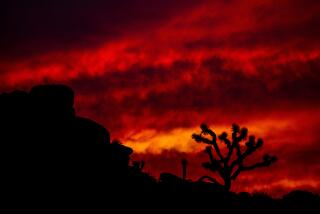Scientists see climate change in action in California wildflower fields
- Share via
Drier, sunnier winters are stressing California’s wildflowers.
These twin trends have conspired to reduce the diversity of wildflower species in a Northern California research meadow by 15% over 15 years, according to a study published this week in the Proceedings of the National Academy of Sciences.
The results offer clear evidence that climate change affects plant diversity on a local scale, said UC Davis ecologist Elise Gornish, who worked on the study.
“Climate-driven diversity decline is occurring at a scale that is visible to the relatively casual observer,” Gornish and her colleagues wrote in the study.
The wildflower loss was evident even when the researchers excluded data from 2013 and 2014, when California’s drought kicked into high gear.
The UC Davis team didn’t set out to study the effects of drought or climate change. When the researchers began their study in 1999, they were curious about the ways that cattle grazing and wildfires affect plant diversity.
Twice a year, scientists headed northwest to the McLaughlin Natural Reserve, a protected area in Napa and Lake counties that is managed by UC Davis for research purposes. Its roughly 7,000 acres serve as a giant outdoor laboratory for ecologists, geologists and biologists, along with 38 other wild areas the University of California maintains across the state.
“They’re really priceless,” said Susan Harrison, a plant ecologist at UC Davis and the lead author of the study, referring to the lands.
Over time, the researchers noticed that the big, intense blooms of wildflowers that used to appear in the spring were becoming less and less frequent. So they decided to analyze changes in plant species over time.
They picked 80 different sites from all over the reserve and counted all of the species growing in five small plots at each site. They also estimated how much area each plant species covered within each plot.
The research team correlated changes in plant growth with changes in rainfall patterns, temperature, cloud cover and humidity.
Across all 80 sites, clusters of native wildflower species became increasingly less diverse from 1999 to 2014, the researchers found. In particular, the species that were disappearing fastest were those with broad leaves, which are most susceptible to drought.
The 15% decline in wildflower species diversity was correlated with about 50% less rain in midwinter, about 20% more sun in fall and winter, and a 20% drop in winter humidity.
The downward trend in midwinter rainfall over the entire reserve was particularly striking, the researchers said. Total rainfall from December to February plunged from about 20 inches in 1999-2000 to about 10 inches in 2013-2014.
“There has always been like a week during January where you go around in your shirtsleeves, but those periods have been getting longer and longer — and warmer and drier — in the past 15 years,” Harrison said.
That’s bad news for wildflowers.
Many types of California wildflowers germinate in the cool midwinter months, Harrison said. For a seedling to survive long enough to make sturdy roots and send up a flower, it needs the soil near the surface to stay moist. If the soil dries, the nascent wildflower will wither and die before it can reproduce.
Even if the total annual rainfall were to stay the same, wildflowers can be affected by the timing of the storms, Harrison said.
To take account of other factors that might affect plant diversity, the researchers made sure about half of the sites were in areas with fertile soils, no grazing and no recent history of fire. The other sites had inhospitable soils, occasional grazing and had burned in 1999. Even when these variables were considered in their model, the link between climate change and wildflower growth held up.
The UC Davis team is continuing to monitor the research sites to see how decreases in wildflower diversity affect larger ecosystem processes such as soil nutrient cycling, pollination and the spread of invasive plants.
But the 80 plots already indicate that California’s grasslands may look quite different in winters to come, Harrison said.
“Instead of seeing a beautiful display of wildflowers, we’d see all grass and no flowers, or just a few flowers,” she said.
For more science news, follow me on Twitter @sasha_hl and “like” Los Angeles Times Science & Health on Facebook.






